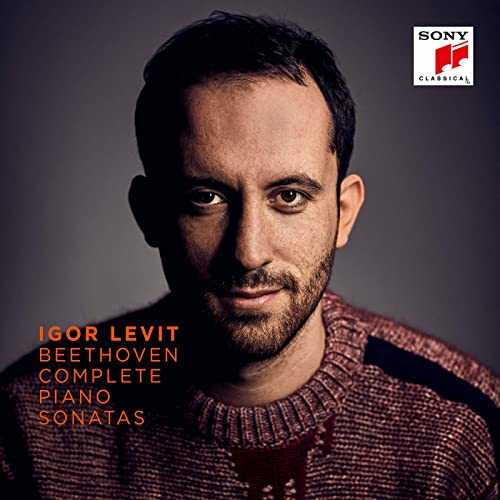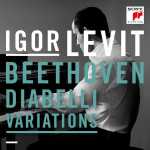
Composer: Ludwig van Beethoven
Performer: Igor Levit
Audio CD
Number of Discs: 9
Format: FLAC (tracks)
Label: Sony
Release: 2019
Size: 8.78 GB
Recovery: +3%
Scan: yes
Beethoven: Piano Sonata No. 1 in F minor, Op. 2 No. 1
01. I. Allegro
02. II. Adagio
03. III. Menuetto. Allegretto
04. IV. Prestissimo
Beethoven: Piano Sonata No. 2 in A major, Op. 2 No. 2
05. I. Allegro vivace
06. II. Largo appassionato
07. III. Scherzo. Allegretto
08. IV. Rondo. Grazioso
Beethoven: Piano Sonata No. 3 in C major, Op. 2 No. 3
09. I. Allegro con brio
10. II. Adagio
11. III. Scherzo. Allegro
12. IV. Allegro assai
Beethoven: Piano Sonata No. 4 in E flat major, Op. 7
13. I. Allegro molto e con brio
14. II. Largo, con gran espressione
15. III. Allegro
16. IV. Rondo. Poco allegretto e grazioso
Beethoven: Piano Sonata No. 5 in C minor, Op. 10 No. 1
17. I. Allegro molto e con brio
18. II. Adagio molto
19. III. Finale. Prestissimo
Beethoven: Piano Sonata No. 6 in F major, Op. 10 No. 2
20. I. Allegro
21. II. Allegretto
22. III. Presto
Beethoven: Piano Sonata No. 7 in D major, Op. 10 No. 3
23. I. Presto
24. II. Largo e mesto
25. III. Menuetto. Allegro
26. IV. Rondo. Allegro
Beethoven: Piano Sonata No. 8 in C minor, Op. 13 ‘Pathetique’
27. I. Grave – Allegro di molto e con brio
28. II. Adagio cantabile
29. III. Rondo. Allegro
Beethoven: Piano Sonata No. 9 in E major, Op. 14 No. 1
30. I. Allegro
31. II. Allegretto
32. III. Rondo. Allegro comodo
Beethoven: Piano Sonata No. 10 in G major, Op. 14 No. 2
33. I. Allegro
34. II. Andante
35. III. Scherzo. Allegro assai
Beethoven: Piano Sonata No. 11 in B flat major, Op. 22
36. I. Allegro con brio
37. II. Adagio con molto espressione
38. III. Menuetto
39. IV. Rondo. Allegretto
Beethoven: Piano Sonata No. 12 in A flat major, Op. 26 ‘March Funebre’
40. I. Andante con variazioni
41. II. Scherzo. Allegro molto
42. III. Marcia funebre sulla morte d’un eroe
43. IV. Allegro
Beethoven: Piano Sonata No. 13 in E flat major, Op. 27 No. 1 ‘Quasi una fantasia’
44. I. Andante – Allegro
45. II. Allegro molto e vivace
46. III. Adagio con espressione
47. IV. Allegro vivace
Beethoven: Piano Sonata No. 14 in C sharp minor, Op. 27 No. 2 ‘Moonlight’
48. I. Adagio sostenuto
49. II. Allegretto
50. III. Presto agitato
Beethoven: Piano Sonata No. 15 in D major, Op. 28 ‘Pastorale’
51. I. Allegro
52. II. Andante
53. III. Scherzo. Allegro vivace
54. IV. Rondo. Allegro ma non troppo
Beethoven: Piano Sonata No. 16 in G major, Op. 31 No. 1
55. I. Allegro vivace
56. II. Adagio grazioso
57. II. Rondo. Allegretto
Beethoven: Piano Sonata No. 17 in D minor, Op. 31 No. 2 ‘Tempest’
58. I. Largo – Allegro
59. II. Adagio
60. III. Allegretto
Beethoven: Piano Sonata No. 18 in E flat major, Op. 31 No. 3 ‘The Hunt’
61. I. Allegro
62. II. Scherzo. Allegretto vivace
63. III. Menuetto. Moderato e grazioso
64. IV. Presto con fuoco
Beethoven: Piano Sonata No. 19 in G minor, Op. 49 No. 1
65. I. Andante
66. II. Rondo. Allegro
Beethoven: Piano Sonata No. 20 in G major, Op. 49 No. 2
67. I. Allegro, ma non troppo
68. II. Tempo di Menuetto
Beethoven: Piano Sonata No. 21 in C major, Op. 53 ‘Waldstein’
69. I. Allegro con brio
70. II. Introduzione. Adagio molto
71. III. Rondo. Allegretto moderato – Prestissimo
Beethoven: Piano Sonata No. 22 in F major, Op. 54
72. I. In Tempo d’un Menuetto
73. II. Allegretto – Più allegro
Beethoven: Piano Sonata No. 23 in F minor, Op. 57 ‘Appassionata’
74. I. Allegro assai
75. II. Andante con moto
76. III. Allegro ma non troppo – Presto
Beethoven: Piano Sonata No. 24 in F sharp major, Op. 78
77. I. Adagio cantabile – Allegro ma non troppo
78. II. Allegro vivace
Beethoven: Piano Sonata No. 25 in G major, Op. 79
79. I. Presto alla tedesca
80. II. Andante
81. III. Vivace
Beethoven: Piano Sonata No. 26 in E flat major, Op. 81a ‘Les Adieux’
82. I. Das Lebewohl. Adagio – Allegro
83. II. Abwesendheit. Andante espressivo
84. III. Das Wiedersehn. Vivacissimamente
Beethoven: Piano Sonata No. 27 in E minor, Op. 90
85. I. Mit Lebhaftigkeit und durchaus mit Empfindung und Ausdruck
86. II. Nicht zu geschwind und sehr singbar vorgetragen
Beethoven: Piano Sonata No. 28 in A major, Op. 101
87. I. Etwas lebhaft und mit der innigsten Empfindung
88. II. Lebhaft. Marschmäßig
89. III. Langsam und sehnsuchtsvoll
90. IV. Geschwind, doch nicht zu sehr, und mit Entschlossenheit
Beethoven: Piano Sonata No. 29 in B-flat major, Op. 106 ‘Hammerklavier’
91. I. Allegro
92. II. Scherzo. Assai vivace
93. III. Adagio sostenuto. Appassionato e con molto sentimento
94. IV. Largo – Allegro risoluto
Beethoven: Piano Sonata No. 30 in E major, Op. 109
95. I. Vivace ma non troppo
96. II. Prestissimo
97. III. Gesangvoll, mit innigster Empfindung. Andante molto cantabile ed espressivo
Beethoven: Piano Sonata No. 31 in A flat major, Op. 110
98. I. Moderato cantabile molto espressivo
99. II. Allegro molto
100. III. Adagio ma non troppo – Fuga. Allegro ma non troppo
Beethoven: Piano Sonata No. 32 in C minor, Op. 111
101. I. Maestoso – Allegro con brio ed appassionato
102. II. Arietta. Adagio molto semplice e cantabile
levit-beethoven-complete-piano-sonatas249602.rar – 1.2 GB
levit-beethoven-complete-piano-sonatas249603.rar – 1.1 GB
levit-beethoven-complete-piano-sonatas249604.rar – 1.1 GB
levit-beethoven-complete-piano-sonatas249605.rar – 1.0 GB
levit-beethoven-complete-piano-sonatas249606.rar – 1.1 GB
levit-beethoven-complete-piano-sonatas249607.rar – 733.3 MB
levit-beethoven-complete-piano-sonatas249608.rar – 949.6 MB
levit-beethoven-complete-piano-sonatas249609.rar – 1013.8 MB
Igor Levit – the recent recipient of the prestigious Gilmore Artist Award and the Royal Philharmonic Society’s “Instrumentalist of the Year”- has now completed the recording of all 32 sonatas of Ludwig van Beethoven. In September 2019 this mammoth studio-recording project will finally be released and leads the way for important new releases on Sony Classical for Beethoven’s 250-year anniversary.
Igor Levit, exclusive artist with Sony Classical says: “For me, this recording is a conclusion of my past fifteen years. The literally life-changing encounter with the Diabelli Variations at the age of 17, which is effectively still ongoing, the daily engagement with Beethoven’s sonatas, with Beethoven as a person, with myself, with the world in which I live – all that has also led to this recording. What I started in 2013 with the last five sonatas, I can now conclude. It fills me with great happiness and at the same time feels like a new beginning. ” Per Hauber, Managing Director Sony Classical says: “Every release of Igor Levit is an event in itself. That this major release is now spearheading the Beethoven anniversary celebrations will, we anticipate, launch the global festivities commemorating one of humanity’s most important artistic figures. To accompany Igor Levit on this long and wonderful path to his complete recording of the Beethoven Sonatas was an unforgettable experience for all of us at Sony Classical.”
The last two discs in this issue, comprising the last five sonatas in the cycle (numbers 28-32) were recorded in Berlin and issued as a two-CD set in 2013, to wide critical approbation. Igor Levit has been recording the other twenty-seven sonatas at intervals between 2017 and 2019, and the complete sonatas are now available, as an early tribute for the Beethoven 250th anniversary year in 2020.
The first disc, with the three sonatas of Opus 2, offers a promising start. The F minor begins the mighty sonata sequence with a steady tempo but a sprightly manner. There is no attempt to over-dramatize the rising scalic figure as a “Mannheim rocket”, and in the finale the many fortissimi register without pounding, and the lyrical episode flows chastely along. The aria of the slow movement is rather cool, too. Again perhaps in the A major (Op.2/2) the Rondo Grazioso of the finale could be more gracious, and the dolce theme of the first movement of the C major sonata (No.3) more sweetly sung. But the third movement has captivating rhythm and the finale ends with as neat a triple trill as even the composer (whose party trick this was) must have managed. With Opus 7 in E flat (second longest of all thirty-two works) the sheer abundance of ideas in the first movement is celebrated by Levit’s seeming affection for each one, and the spacious Largo con gran espressione is expertly delineated in both its hymn-like and operatic moments.
Opus 10/1 disappoints somewhat and at first I was not sure why. A quick check against the rather unsung Mari Kodama on Pentatone showed that a slightly slower tempo (she takes 5:34 versus Levit’s 4:57) for the first movement permits better – and wittier – articulation of the opening phrase, and savours Beethoven’s play of strong and weak bars (on which Rosen’s book on the sonatas is so intriguing) rather more. So too with the finale, her 4:29 offers more light and shade than Levit’s 4:05. But it is marked Prestissimo after all and Levit certainly offers high octane playing. Staying with the Kodama comparison for a moment, the next sonata Op.10/2 also has a Presto finale, and her 4:09 sounds rather staid alongside Levit’s neatly articulated and persuasive 2:09. Again with Op.10/3 the swiftness (6:07) of Levit’s opening movement is persuasive also, but so too is Kodama’s 7:15. It is Levit who offers the thrill of sheer impetus, while Kodama’s steadiness offers the more cumulative sense of momentum. Opus 2, 7 and 10 are all 18th century works still nodding to Mozart and Haydn, and Levit sounds rightly concerned to keep them in scale, while remembering that they also were intended to advertise to the Viennese the skill of the young virtuoso in town.
Of course it’s hardly all about fast playing. Thus Opus 10/3 has a noble slow movement (Largo e mesto) and here Levit seeks to plumb the depths with a very slow 10:12, when Kodama’s 9:19 sounds more affecting and Kempff’s 1951 account takes just 8:45 to achieve still greater pathos – we are still in the 18th century here, for all the proto-romantic feeling at times. In the famous Adagio cantabile of the “Pathétique” Sonata, Kodama’s 5:15 is the outlier against Levit’s nicely paced 5:03, while Kempff trots along at 4:05, closer to ‘andante cantabile’. In fact this Op.13 finds Levit at his best throughout, with the tempo of each movement and episode nicely judged and immaculately executed. So too with the ‘easy’ pair of Opus 14 sonatas. They might be designed for wide domestic use, but Beethoven never writes down to the player, and neither does Levit condescend to his listeners, treating these works as the high-class entertainments they are, well worthy of the attention of a top professional player. The Scherzo finale of Op.14/2 is especially jocund, the player clearly relishing Beethoven’s rustic humour. The pair of Op.49 two-movement sonatas (from the 1790’s despite the opus number) are similarly given polished, appreciative performances, much more in keeping with their style than the recent recording of them, also on Sony, by Ivo Pogorelich.
Beethoven was more than satisfied with his Opus 22 which remained a favourite of his, if not of everyone since. Glenn Gould called it a “dud”, but Levit’s account makes it sound as if he rather admires it, giving a restrained, measured performance that places it as the end of the 18th century sonatas (which it is) rather than as a harbinger of a new dawn. Op.26 in A flat is from 1800 but that too sounds like a continuation perhaps because of the rather traditional variations of the first movement which Levit plays with a certain guileless insouciance, as he does the following scherzo. The funeral march is a bit too dirge-like in tempo fully to hold the attention perhaps, and the finale is another rather hectic piece, over in a flash. Op.27/1 suffers no such blemish, another very satisfying version of a less well-known sonata. Most well-known of all is Op.27/2 the “Moonlight”, where the haunting effect of the opening movement depends much on the use of the pedal (on the early piano) in relation to the left hand part. Levit seems to have found the right method for his particular modern instrument, and the recorded sound captures it well. I wished at times the finale had a little of the same poise, even though it might seem odd to wish for poise in a movement marked presto agitato. The opening movement of the “Pastorale “sonata could not be more poised, and the march of the Andante is ideally steady, while by now we can expect Levit to respond with rhythmic acuity to Beethoven’s humour in the Scherzo and in the rusticity of the drone-led finale.
There is comedy too to be found in Op.31/1, in Beethoven’s musical manners (as in the asynchronous treatment of the hands at the outset), and in Levit’s performance. The bel canto of the second movement is beautifully ‘sung’ at the keyboard, and the Rondo sings almost as ingratiatingly. Op.31/2, the “Tempest” sonata, is dramatic indeed, Levit conjuring a storm in the first movement with some incandescent playing and a wide dynamic range with some remarkably soft passages. The Adagio is at a tempo which initially threatens to stagnate, but which Levit’s concentration just maintains. The steady perpetuum mobile of the finale is well maintained too, never disrupted even by Levit’s attention to its passing incidents. Op.32/3 especially benefits from the precision of Levit’s articulation of tricky passagework, and his control of dynamics, all at an ideal tempo in the first and second movements, the latter a delightful tour-de-force here in another strong all-round performance.
The “Waldstein” (Op.53 in C) is of course one of Beethoven’s great middle-period works, and gets a performance of high energy and commitment, with a fast tempo that still permits precision of figuration most of the time. The Adagio molto that leads attacca to the finale is pregnant with suspense at a very slow pace, and the rondo theme is spacious and noble up until the coda with its various technical challenges and display effects, when the prestissimo close is here of the sort to bring the audience to its feet. The two movement F major work Op.54 has a graciously played minuet opening, its comically rumbustious trio given with vigour, and a relentless finale with expertly played toccata figuration. The “Appassionata” Op. 57 is powerful and tragic in any good performance, such as that here. After a slightly matter-of-fact opening, (nothing too portentous here), the piece explodes into ferocity, but the alterations between those outbursts and the quieter passages are well stage-managed by Levit, such that this momentous movement makes a properly cumulative impact. The Andante is designated con moto and flows along in the way that marking implies, right until the eruption into the Allegro finale. Here Levit observes Charles Rosen’s observation that the ma non troppo qualification “should be taken sufficiently seriously so that the Presto at the end can be almost double tempo”. Except perhaps for that “almost”! If all the scores disappeared I am not sure we could reconstruct the notes exactly from this recording of the coda, but it is certainly headlong and exciting.
The relatively small two-movement sonata Op. 78 is given all the lyrical charm required, as is the Op.79 sonatina – once more Levit does not short change the listener in these more modest or at least more intimate works. Rather he shows us that Beethoven may have huge range in these works, but never really nods off creatively. The Allegro vivace of Op.78 is a bit over-vivacious at Levit’s fast pace but Op.79 is a delight throughout (fast Vivace finale included). With “Les Adieux” Op.81a we again have a fine account right up until the dash to the finish line. True a return to ‘Tempo 1’ is indicated, and that is marked Vivacissimamente, i.e. ‘liveliness carried to the ultimate degree’. And Levit can still get round all the notes. Op.90 in E minor is superbly done, the concentration of form in the first movement matched by Levit’s sense of engagement with every note. The second movement is wonderfully lyrical; I once was given it in a quiz and knew that of course it was by Schubert – I still don’t feel I deserved my team’s scorn for losing a point. And after hearing Levit play it so well I would like to hear him in Schubert.
The last five sonatas are already widely known to be a very fine climax to the whole cycle, and I can still hear why they are held in such high regard, not least as Levit was 26 when they were released first as a 2-CD set. It was Recording of the Month then on this site (review) and it is still available separately. They have the best elements of all that can be heard in the earlier sonatas, both lyrical and technical with a feeling for the elusive forms as in the first movement of Op.101, and the fugal finale of the “Hammerklavier” is a tour-de-force. Op.111 is a work I have always found elusive. (But then I can be heretical about an artist’s late works, believing there always to be losses as well as gains.) But this Op.111 I found very satisfying indeed. The claim that Levit’s late sonata recordings sweep all others aside (heard from at least one critic) is an absurd exaggeration. No-one should abandon Gilels in Op.101 or Pollini in Op.106, for instance, let alone Solomon or Schnabel (Levit’s obsession it seems). But in 21st century terms, these are the major recordings of the summit of the cycle.
There is little difference, if any, in the excellence of the sound in the late works and in the sonatas recorded later on in 2017-19. The booklet in this new complete cycle is a good one, with a short note on every sonata by Anselm Cybinski, who also interviews Levit fairly fully about the project. Both those notes are in English and German. The sonatas are sensibly organised on the discs, in order of publication, so it easy to find a particular work. Overall this is an important cycle, carried along by ferocious commitment and concentration, an impressive technique, and a fearless attitude to interpretation, especially tempi. As Beethoven’s 250th anniversary approaches, Igor Levit’s is without doubt the Beethoven sonata cycle of the moment, if not one for the ages.



